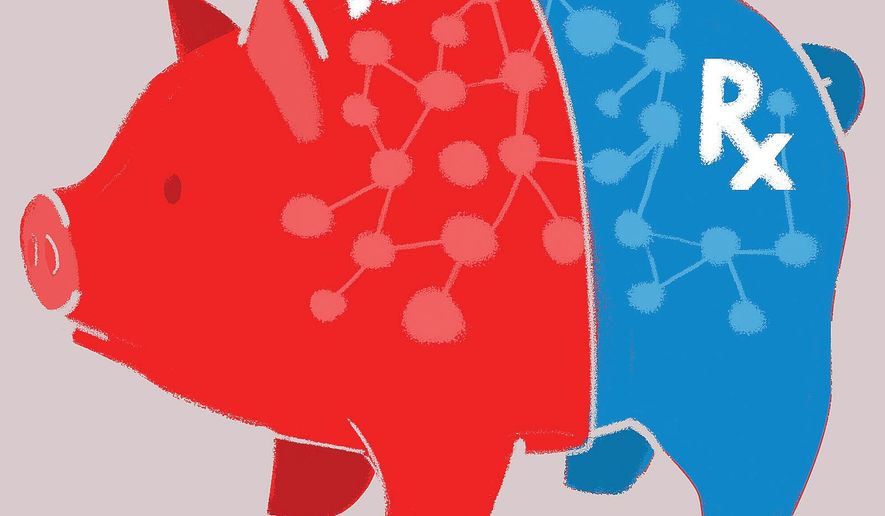OPINION:
Anyone who was paying attention to President Trump’s May 11th press conference on drug pricing or has read the White House Blueprint understands that drug pricing is an ecosystem that includes manufacturers and multiple intermediaries. Games are being played and patients are (generally) the losers.
The president and his team are voicing free-market solutions. The big take-away from the president’s speech is that “the price of drugs” is an ecosystem problem that requires an ecosystem solution. It’s the ecosystem, stupid.
Shame on those who perpetuate the myth that drug prices are a one-dimensional issue. And shame those who chose to ignore the many solid recommendations made by the president and his health care team.
It’s high time we focused on the questionable practices of Pharmacy Benefit Managers. PBMs receive large rebates and pocket hundreds of millions of dollars rather than pass savings onto patients. President Trump and HHS Secretary Alex Azar said they will demand that these rebates be used to lower patient co-pays at the pharmacy. When people say, “My drugs are too expensive,” what they mean is “My co-pay” or “My deductible” is too expensive.
This truth telling isn’t surprising since POTUS is following the lead of three very sharp policy wonks Mr. Azar, Food and Drug Administration Commissioner Scott Gottlieb and Seema Verma, administrator of the Centers for Medicare and Medicaid Services. And they’ve been saying this for years. In fact, Mr. Azar talked about it during his confirmation hearing.
The president’s budget calls for insurers/PBMs who provide Medicare Part D prescription drug plans to give at least one-third of the rebates to beneficiaries at the pharmacy.
The big policy implication here is the major flaw in the Affordable Care Act. The ACA promised “insurance for all.” Such rhetoric led people to believe their health care would be “free.” Not so.
Many of the ACA plans are low premium/high co-pay. Millions of Americans have learned that “having insurance” and “having access to health care” isn’t the same thing. New thinking from the president’s health care team begins to get at this foundational policy problem.
The next policy conversation will be “Do lower co-pays mean higher premiums?” Watch for the payer pundits to ask this question. Ultimately, one man’s rebate is another man’s kickback. Will the federal exemption for rebates be revoked? Big battle here that PBMs cannot afford to lose.
The large and growing gap between drug’s list prices and the actual, secret prices PBMs pay is bad for competition. Markets are less efficient without clear price signals. The proposed HHS rule (for passing along a portion of the rebate) would improve price transparency and have a positive effect on competition and efficiency. After all, it’s harder to pocket rebates when they’re sitting on the table where everyone can see them.
The administration may also consider how it pays for drugs administered in doctor’s offices, clinics or hospitals through Medicare’s Part B program. The federal government currently pays providers 6 percent more than the average price of those medicines. Manufacturers have the incentive to raise prices and give providers the incentive to select more expensive medicines.
One of the blueprint’s more aggressive suggestions is considering moving certain Part B coverage into the Part D program, where insurers can negotiate better prices. While the Part B program would certainly benefit from the infusion of competition, we should also recognize the value of the existing transparency of its Average Sales Price model.
Crucially, the Blueprint recognizes that states are the laboratory of invention. Since reducing Medicaid drug costs is also under consideration, the president’s budget calls for giving up to five states greater leeway to test drug coverage and payment models in their Medicaid programs.
Allowing states to determine which drugs to cover would in theory allow them to negotiate bigger discounts directly with manufacturers.
The FDA is focusing on reducing prices by increasing competition. Mr. Gottlieb plans to tackle the “shenanigans” manufacturers play to keep competitors off the market — such as using loopholes to block rivals, paying them to delay bringing drugs to market, and for biosimilars, using exclusionary contracting.
And Mr. Gottlieb’s initiative to shame companies that refuse to support generic initiatives is the first in what will be many strategic salvoes to lower drug costs.
Per other nations’ “bullying our drug manufacturers into unrealistically low prices/allowing other countries to freeload off of American innovation” — it’s a fair point that’s going to be difficult to address. But the fact that the president is addressing it is a big step in the right direction.
The experts at the wheel of drug pricing reform are focusing on free-market solutions. Their ideas require an ecosystem approach. Nobody said it was going to be easy.
• Peter J. Pitts, a former FDA associate commissioner, is president of the Center for Medicine in the Public Interest.




Please read our comment policy before commenting.